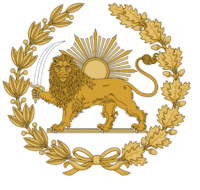Royal Qalehi Navy
This article is incomplete because it is pending further input from participants, or it is a work-in-progress by one author. Please comment on this article's talk page to share your input, comments and questions. Note: To contribute to this article, you may need to seek help from the author(s) of this page. |
| Qalehi Navy | |
|---|---|
| نیروی دریایی سلطنتی قله | |
 Seal of the Royal Qalehi Navy | |
| Active | 1802–present |
| Country | |
| Type | Navy |
| Role | Naval warfare |
| Size | 58,900 active duty (2017) |
| Part of | Qalehi Armed Forces |
| Headquarters | Narawh Square, Dahrzor |
| Motto(s) | "برای شاه و کشور" (For Shah and country) |
| Colors | White, Gold, Burgundy |
| March | "نیروی دریایی مارس" (English: "Naval March")[[1]] |
| Equipment | 1 light aircraft carriers 8 cruisers 13 destroyers 13 corvettes 17 submarines 11 frigates 30 patrol boats 7 mine countermeasures vessels 4 amphibious assault ships |
| Engagements | Qalehi Civil War Kasahgan War Arian Summer |
| Commanders | |
| Commander of the Navy | Shahanshah Ahmad Rouhani |
| Admiral | Admiral Farhad Loristani |
| Vice Admiral | Vice Admiral Salman Rezghi |
The Royal Qalehi Navy (Qalehi: نیروی دریایی سلطنتی قله), commonly abbreviated to RQN, is the naval warfare branch of the Qalehi Armed Forces, the military of Qal'eh.
The navy forms Qal'eh's first line of defense in the Decanian Sea, and is pivotal in the protection of national sovereignty. The navy also plays a large role in the administration of the Kasahgan Peninsula.
The sole maritime branch of the Qalehi Armed Forces, the RQN holds all of Qal'eh's naval prowess, including large attack ships like destroyers, frigates and cruisers. As well as tactically-oriented ships, such as amphibious assault craft, all four of which are important for the projection of Qalehi power overseas.
Overview
The Royal Qalehi Navy underwent a massive modernisation program in the 1970s and 80s after the collapse of the FSR following the FSR Civil War primarily initiated by Farid Hashempour Rouhani, the 12th Shahanshah of Qal'eh. The aim of the modernisation program was to secure Qalehi naval dominance in the Decanian Sea and to take advantage of its neighbouring, ex-FSR countries' dwindling industries due to post-civil war damages. The Dahrzor-class corvette in 1978 and the Arzet-class destroyer in 1982 were the first ships to be laid down as part of the modernisation program. The ships allowed for Qalehi power projection across the coastal states of Sifhar and strengthened its trading capabilities with the countries of northern Majula and sometimes even as far as Asura, Arabekh and Catai.

The modernisation program continued successfully and in 1983 Hossein Nemati Rouhani approved 141.5 billion Zaar (~$50 billion) of funding to be designated to the RQN's modernisation program starting in 1984 and ending in 1989, almost the entire military budget at the time. As a result of this vastly disproportionate funding, the army and air force suffered, the air force in particular suffered a 50% personnel callback and 30% of its equipment being decommissioned, sold or scrapped.
Navy funding has been curtailed in Qal'eh today, although it still remains the most funded branch of the armed forces. The navy's main surface combat ship is the Aftab-class destroyer, introduced in 2011, of which the RQN operates eight to replace its aging Arzet-class destroyers. The RQN is also beginning to focus more on its fleets' speed, shock and manoeuvrability as opposed to its surface brute-force power. The increase in smaller, quicker and more modern ships like the X-class corvette and the increase in submarines coupled with the 2010 introduction of the X-class submarine to modernise its submarine fleet and to introduce air-independent propulsion into the country's submarine fleet. The country has de facto navally allied itself with Sidi Synnia and the two countries regularly work together in naval development as well as anti-piracy operations throughout Sifhar.
History
Facilities
List of currently commissioned RQN ships
| Ship name | Hull no. | Class | Type | Commission date | Homeport |
|---|---|---|---|---|---|
| HQMS Omid Yazdan | CR-009 | Omid Yazdan-class | Aircraft carrier | 18 June 1996 | Khazam Yek |
| HQMS Parwaza | CS-062 | Berazend II-class | Cruiser | 5 January 2000 | |
| HQMS Shala | CS-062 | Berazend II-class | Cruiser | 5 January 2000 |
Population: 52,981,727 · Capital: Dahrzor · Languages: Qalehi, Arvian | ||
| History | ||
| Politics | ||
| Military | ||
| Geography | ||
| Economy | ||
| Demographics | ||
| Culture | ||
| Symbols | ||


